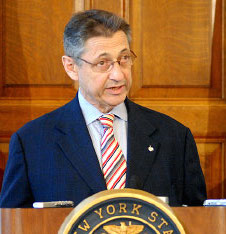
With prosecutors in vestigating possible criminal misconduct in former state Comptroller Alan Hevesi’s management of New York’s $155 billion state pension fund, there’s talk in Albany about making fundamental changes in the powers of the comptroller’s office.
The state Constitution now gives the comptroller sole responsibility and control over the fund. But now it’s been reported that Hevesi and his top deputy may have received favors from firms paid to manage pension investments.
In that light, Gov. Spitzer says it’s “worth taking a hard look at” whether control of the money should be shifted from the comptroller as sole trustee to a board of trustees, likely one made up of both elected officials and public-employee representatives. Citing “very troubling, serious, systemic conflicts of interest,” Attorney General Andrew Cuomo is mulling an endorsement of the board concept.
But taking responsibility away from the elected comptroller and putting it in the hands of a board wouldn’t erase these conflicts of interests. And it would reduce accountability at the pension fund, not increase it.
Most other states, as well as New York City, have pension funds controlled by boards rather than by sole trustees. But this hasn’t prevented illegal activity or mismanagement. To wit:
In Illinois, the feds charged last year that in 2003 and 2004, an appointed board member of the state teachers’ pension fund colluded with a developer to extort millions in kickbacks from banks and investment firms seeking pension-fund business.
In Ohio last year, two board members at the police and fire pension fund pleaded guilty to taking thousands of dollars in gifts from companies with pension-fund business; separately, four board members of the teachers’ fund pleaded guilty or no contest to similar offenses, and a fifth was convicted.
The case of San Diego is especially instructive. Prosecutors charge that trustees of that city’s pension fund – including union representatives – violated a “conflict of interest law”: They allowed the city to cut its payments to the plan, making it seem like the city had more money to pay for better benefits for public employees. In reality, the shift caused a huge deficit at the fund.
If New York amends its Constitution to set up a board to run the state pension fund, the board would inevitably include representatives of the state’s powerful government unions. As California’s state pension fund, Calpers, has repeatedly shown, a board that includes union reps and union-friendly politicians can use the clout of the fund’s billions in taxpayer dollars to try to make companies behave in union-friendly ways, not always good for the bottom line.
In truth, a $155 billion pot of money will always be a potential source of temptation to anyone and everyone with a hand in steering its investments.
The best way to minimize corruption in the management and investment of New York’s government retirement plans is to follow states like Michigan and Alaska, which are shifting newly hired workers to individual accounts, such as the 401(k) plans common in the private sector.
Instead of managing money, the comptroller would manage the competition for individual retirement investments among as many mutual-fund and index-fund firms, banks and other investment companies as can meet some basic standards. Workers could control their own discount-brokerage retirement accounts should they choose, provided they don’t exceed certain pre-defined limits like invest too high a percentage of their money in one company, sector or asset class.
That would be real reform – the kind of “completely new paradigm” that Spitzer has embraced in other contexts.
Either way, of course, the state pension fund in its current form will be around for another generation: The state can’t take away benefits already promised to today’s workers and retirees. But it would be best to keep the fund’s management just the way it is. Under the current system, the buck stops with the comptroller and sole trustee, now former Assemblyman Thomas P. DiNapoli.
It’s true that no one can guarantee that any comptroller will do a particularly good job, or even abstain from illegal activity. But as DiNapoli says, “the ultimate accountability is at the ballot box.” Actually, he didn’t go far enough: the ultimate accountability is the possibility of criminal charges and jail time.
No governance structure is a guarantee against poor performance, or even criminality. But with a sole trustee, at least we’ll know whodunit.



